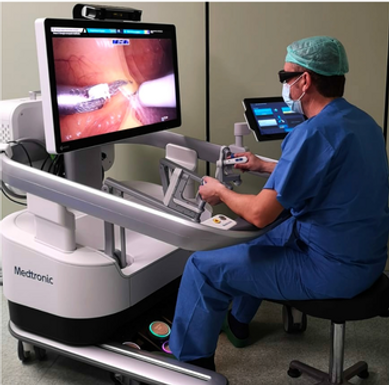Medtronic Internship 2023
HUGO™ RAS System Input Arm Work Envelope for Reliability Platform
Introduction and Background
During the summer of 2023, I interned in Medtronic’s Surgical Robotics sector, focusing on the Hugo™ Robotic-Assisted Surgery (RAS) System. My work involved developing an automated methodology to record and analyze the 3D trajectories of the system’s input arms. After generating and processing the data, I provided it to the Surgical Robotics Reliability team, enabling them to identify ways to optimize the manipulability of the input arms. This effort enhanced surgeons’ control and precision during complex robotic-assisted surgeries.
The Hugo™ Robotic-Assisted Surgery (RAS) System is Medtronic’s cutting-edge platform designed to bring the benefits of robotic-assisted surgery to more patients and healthcare settings. It combines the precision of robotics with the versatility of traditional laparoscopy, giving surgeons greater control and better visualization during complex procedures. The system is designed to improve surgical outcomes, reduce recovery times, and make minimally invasive surgeries more accessible worldwide.
The system consists of several key components: the RAS Arm Cart (1), which includes modular surgical arms that can be configured for different procedures; the Surgeon Console (2), providing surgeons with immersive 3D HD visualization and precise instrument control; and the RAS Tower (3), which acts as the central processing unit and delivers high-quality imaging. Additionally, the system includes a Task Simulator for surgeon training and a variety of wristed instruments, offering enhanced dexterity and seven degrees of freedom.


Figure 1: Hugo™ RAS System Components (Medtronic).
Figure 2: Hugo™ RAS Arm (Medtronic).
The input arms, the key components I worked with, are located at the front of the Surgeon Console. These arms feature eight joints, with each joint comprising one motor and two encoders. The motors are equipped with advanced functionalities such as gravity compensation, force feedback, and friction compensation, ensuring smooth and controlled movements. This design provides a wide range of motion, enabling surgeons to perform complex robotic-assisted surgeries with enhanced dexterity. My role involved analyzing the RASA trajectories, which define the system’s safe and efficient movement paths, to further optimize the input arms’ responsiveness and reliability during surgical procedures. This work was essential for improving the overall control and precision of the Hugo™ RAS System.

Figure 3: Surgeon Console Input Arms (Medtronic).

Figure 4: Surgeon Manipulating the Input Arms (Medtronic).
Heatmap Comparison
To analyze the RASA trajectories of the input arms, I developed a precise method to move them in 3D space, simulating the full range of movements a surgeon might perform during a surgical procedure. Using a UR5 robotic arm, I programmed it to guide an input arm through a specific routine, collected 3D position data from these simulated movements, built a simple program to visualize the data as heatmaps, and compared the results to those generated by the Surgical Robotics scientific division’s mathematical models.
Results
Using the data collected through the UR5-input arm routine, I developed a simple application to visualize the results. This tool enabled my team to accurately examine the input arm’s experimental work envelope, compare it to the theoretical work envelope generated by the scientific division, and leverage these findings to enhance the manipulability and reliability of the Hugo™ input arms.

Figure 5: Example Work Envelope Visualization.
My Role
-
Designed and implemented an automated methodology to execute recorded trajectories from real surgical procedures, driving the Hugo™ RAS Surgical Robotics System input arm using the Universal Robots UR5/CB3 Cobot, URScript, and the PolyScope interface.
-
Developed a Python application leveraging Matplotlib to process trajectory data and generate an interactive work envelope visualized through 3D heatmaps.
-
Documented the project comprehensively and delivered a presentation on findings to Medtronic’s surgical robotics reliability team.
Key Outcomes
-
Data-driven results enabled the team to optimize the input arms’ manipulability, enhancing surgeons’ control and precision during complex robotic-assisted surgeries.
-
Presented findings to Medtronic’s surgical robotics reliability team.
-
Authored detailed project documentation for knowledge transfer and reproducibility.
Acknowledgements
I would like to thank my manager, Cord Mueller, for his check-ins, mentorship, and invaluable career advice; my peer mentor, Colin Huang, for his guidance, insightful site tours, and career insights; Edward Pineda, my main point of contact during the project, for his clear explanations, advice, and mentorship; Gary Suszynski for his valuable check-ins and guidance; and Peter Savino for his lab assistance and positive attitude. I deeply appreciate the support and collaboration of the entire team and everyone I had the pleasure of meeting during the internship. Thank you all for making this an enriching and unforgettable experience!


